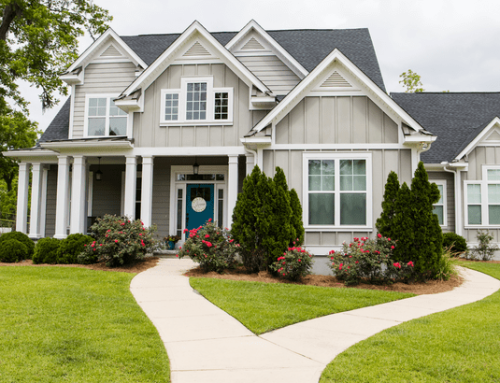As temperatures start to soar, the summer heat can become unbearable. Summer temperatures in Texas can be brutal, with daily highs regularly reaching into the 90s and sometimes surpassing 100°F! While cranking up the air conditioning may provide temporary relief, it can also result in sky-high energy bills and increased carbon emissions. Did you know that the United States has some of the highest energy consumption rates per capita in the world? In fact, buildings account for 39% of total energy use and 38% of carbon emissions in the country (U.S. Department of Energy). By reducing your energy usage, not only will you save money, but you’ll also be doing your part in protecting the planet. As a homeowner, there are steps you can take to prepare your home for summer temperatures while improving energy efficiency. Here are some tips I’ve compiled from the U.S. Department of Energy to help you get started:
- Seal Air Leaks: Air leaks in your home can cause up to 10-30% of your cooling and heating energy to be wasted, making your air conditioning system work harder than it needs to. Check for drafts around windows and doors, electrical outlets, and other openings. Seal them using caulk or weather stripping to prevent cool air from escaping and hot air from entering your home. According to the U.S. Department of Energy, sealing air leaks can save homeowners up to 20% on heating and cooling costs (Air Sealing Your Home. U.S. Department of Energy).
- Use a Programmable Thermostat: A programmable thermostat can help you save energy and money by automatically adjusting the temperature of your home based on your schedule. By setting your thermostat to a higher temperature when you’re away or sleeping, you can save up to 10% on your energy bills (Programmable Thermostats. U.S. Department of Energy). Programmable thermostats can be easily installed and programmed to fit your schedule and preferences.
- Install Ceiling Fans: According to Energy.gov, ceiling fans are an affordable and energy-efficient way to keep your home cool during summer. They use far less energy than air conditioning units and can make a room feel up to 10 degrees cooler. By circulating air throughout your home, ceiling fans can also help to reduce hot spots and create a cooling breeze. Make sure to set your fan’s direction to rotate counterclockwise during the summer months, which will create a downward airflow and create a wind-chill effect (Ceiling Fan Facts. U.S. Department of Energy).
- Upgrade Your Insulation: Proper insulation is essential for keeping your home cool in the summer and warm in the winter. If your home is poorly insulated, hot air can seep in and cool air can escape, making your air conditioning system work harder than it needs to. Upgrading your insulation can save you up to 15% on your cooling costs. Consider adding insulation to your attic, walls, and floors to improve your home’s energy efficiency (Home Insulation. U.S. Department of Energy).
- Plant Trees and Shrubs: Strategic landscaping can help keep your home cool by providing shade and blocking the sun’s rays. By planting trees or shrubs on the east and west sides of your home, you can reduce the amount of direct sunlight that enters your home, keeping it cooler. Trees and shrubs also improve air quality, reduce noise pollution, and provide natural habitats for wildlife (Arbor Day Foundation).
- Maintain Your Air Conditioning System: Regular maintenance of your air conditioning system can help it run more efficiently and last longer. Replace air filters monthly, clear debris from around the outdoor unit, and have your system inspected by a professional at least once a year. Proper maintenance can help you save money on repairs and replacements while ensuring that your system runs smoothly during the summer months (Air Conditioner Maintenance. U.S. Department of Energy).
- Use Energy-Efficient Appliances: Appliances such as refrigerators, washing machines, and dishwashers account for a significant amount of energy use in the home. When purchasing new appliances, look for those with the ENERGY STAR label, which indicates that they meet energy efficiency standards set by the Environmental Protection Agency. ENERGY STAR appliances can help you save up to 30% on your energy bills. Additionally, consider using your appliances during off-peak hours when energy demand is lower, such as early morning or late evening (Appliances and Electronics. U.S. Department of Energy).
- Install Window Treatments: Another way to keep your home cool and energy-efficient is by installing window treatments such as blinds, curtains, or shades. These treatments can block out sunlight and prevent heat from entering your home, which can reduce the need for air conditioning. Choose window treatments with a high Solar Heat Gain Coefficient (SHGC) rating, which indicates how well the treatment can block heat from the sun. According to the Department of Energy, window treatments can reduce heat gain by up to 77% (Window Treatments. U.S. Department of Energy).
- Switch to LED Bulbs: LED bulbs use up to 75% less energy than traditional incandescent bulbs and last up to 25 times longer. By replacing your home’s five most frequently used light fixtures or bulbs with ENERGY STAR-rated LEDs, you can save you up to $75 on energy bills (LED Lighting. U.S. Department of Energy).
As temperatures rise and summer approaches, it’s important to be proactive about reducing your energy use and improving your home’s efficiency. By implementing these energy-saving tips, you can prepare your home for the upcoming summer heat and save money on your energy bills. As a knowledgeable agent in the Austin area, I am here to help you navigate the home buying and selling process and provide expert guidance on all things home related. Don’t hesitate to contact me for more information or guidance. Let’s work together to make your home a comfortable and eco-friendly oasis in the heart of Austin this summer. Together, we can make a positive impact on the environment, and your wallet!
Sources:
- U.S. Department of Energy. “Buildings Energy Data Book.” 2019, https://www.energy.gov/eere/buildings/downloads/2019-buildings-energy-data-book.
- U.S. Department of Energy. “Energy Saver 101: Home Cooling Infographic.” Energy
Saver, 22 June 2021, www.energy.gov/energysaver/articles/energy-saver-101-home-cooling-infographic. - “U.S. Energy Consumption by Source and Sector, 2020 – Today in Energy – U.S. Energy Information Administration (EIA).” U.S. Energy Information Administration, 2 February 2022, https://www.eia.gov/todayinenergy/detail.php?id=48396.\
- “Air Sealing Your Home.” Energy.gov, U.S. Department of Energy, 5 January 2022, https://www.energy.gov/energysaver/weatherize/air-sealing-your-home.
- “Programmable Thermostats.” Energy.gov, U.S. Department of Energy, 15 April 2021, https://www.energy.gov/energysaver/thermostats/programmable-thermostats.
- “Ceiling Fan Facts.” Energy.gov, U.S. Department of Energy, 6 January 2022, https://www.energy.gov/energysaver/design/energy-efficient-home-design/cool-roofs-ceiling-fans-and-other-diy-cooling-options/ceiling-fan-facts.
- “Home Insulation.” Energy.gov, U.S. Department of Energy, 29 September 2021, https://www.energy.gov/energysaver/weatherize/insulation/home-insulation.
- “Benefits of Trees.” Arbor Day Foundation, https://www.arborday.org/trees/benefits.cfm.
- “Air Conditioner Maintenance.” Energy.gov, U.S. Department of Energy, 5 January 2022, https://www.energy.gov/energysaver/home-cooling-systems/air-conditioning-systems/air-conditioner-maintenance.
- “Appliances and Electronics.” Energy.gov, U.S. Department of Energy, 12 October 2021, https://www.energy.gov/energysaver/appliances-and-electronics.
- “Window Treatments.” Energy.gov, U.S. Department of Energy, 5 January 2022, https://www.energy.gov/energysaver/energy-efficient-window-treatments.
- “LED Lighting.” Energy.gov, U.S. Department of Energy, 14 January 2022, https://www.energy.gov/energysaver/save-electricity-and-fuel/lighting-choices-save-you-money/led-lighting.







Leave A Comment